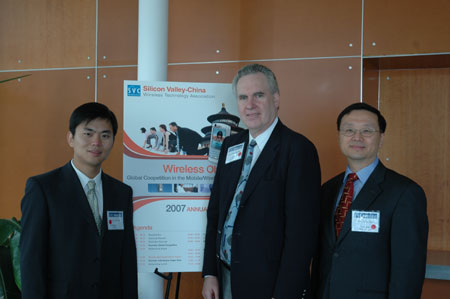Wireless professionals wired up about US-China markets
Updated: 2007-10-05 16:47
Chen's presentation was the highlight of the sixth run of the SVCWireless conference. The enthusiastic attendees find the conference an information centre for the most current market news on the crest of the high-tech industry in both the China and US markets.
"I come here to learn the latest news and trends of applications of our technology," said Mr. Gene Summerville, a project manager with Wireless Matrix.
Establishing an educational and informative platform for all the wireless professionals across the Pacific is indeed what the conference strives to achieve, according Dr. Wen-Pai Lu, the president of SVCWireless, who works for Cisco Systems.
Many of the attendees, such as Mr. Ernest Garcia, CEO of Direction 21, a consulting firm for the China-US-Latin American markets, find the conference a networking hot spot. Mr. Garcia, having been in the US China market for nine years, was nominated as the best businessman for cross-Pacific business development by Mark Chandler, the Director of the San Francisco Mayor's International Trade and Commerce at the conference.
Indeed, it is not only the US professional who benefits from the conference, but their Chinese counterparts flying in a day for the weekend event thinks it "a great venue to understand the US market and the difference in the wireless journey in two countries," commented Thomas Yang, CEO of Lonpan Communication Inc, based in Jiangsu Province in China.
Yang's company cooperates with Dr. Chen in many projects including the Chinese National Railway in the deployment of its wireless network. Dr. Chen's
Integral Grid project attracted the most interest of the conference attendees. The vision of the Integral Grid is to run multi-functional applications simultaneously. For example, if one runs the Video-on-Demand and IPTV applications on one side of the Grid, and healthcare, education or financial services can run on the other side. Later during the day the whole Grid can run Weather Forecasting. Dr. Chen believes the pervasive use of Grid Supercomputers could bring China to the forefront of Supercomputer applications in the next five years. Dr. Chen foresees the Grid Supercomputers available as a commercial service on the Internet, allowing highly productive, real-time, interactive and collaborative enterprise or personal applications in science, engineering, commerce, telecommunication, healthcare, education, media, finance and logistics.
The successful Cray Supercomputer Dr. Chen designed in the 80's is the second generation of the model now on exhibit at the Computer History Museum. Dr. Chen, however, never sat on his early success but has become a continuous inventor in the last thirty years, building upon his early innovation design.
"We normally eat our babies in this industry," said Dr. Mark Cummings, co-chair of the conference and veteran advisor for SVCWireless. His analogy referred to the constant upgrading in the wireless and computer industry without drawing on historical knowledge and experience. Indeed it is important to use the past knowledge and build the future from the history to create new devices such as Dr. Chen is working on.
 |
|
Dr. Yuan Tian, Dr. Mark Cummings and Dr. Wen-Pai Lu at the conference in the Museum of Computer History.[Photo by Ramesh Dimba] |
Dr. Cummings stated a purpose of the conference is also to educate upcoming wireless entrepreneurs by bringing in mentors such as Dr Chen, as he believes Dr. Chen not only delivered the most interesting super computer development in China but also sets an example for young, aspiring wireless professionals to achieve further and make a difference for China and the world by designing and applying the latest technology. Both Mr. Cummings and SVCWireless conference co-chair Dr. Yuan Tian envision their association will play a crucial role in the continuous professional education for the upcoming wireless specialists and entrepreneurs both in China and in the US.
By establishing strategic alliances with The China Mobile Communications Association and The Beijing Telecommunications Information Association last year, SVCWireless hopes to hold future, workshops, seminars and conferences in Beijing, the center of China's tech start-ups.
It is now the fifty year since the start-up culture was created by Fairchild Semiconductors with Gordon Moore and Robert Noyce as they led eight engineers to set up Intel in 1957. The new trend of American venture capitalists moving to Shanghai and Beijing together with the fact of tech employment soaring in China brings concern of the future of the original Silicon Valley. In comparison to the energy and activities across the Pacific, the aging signs of the Valley, from crowded traffic to expensive housing and empty office spaces, paint a less promising picture.
Many in the conference believe that the future of Silicon Valley will lie in cooperating with other innovation centers nationwide and worldwide, to take advantage of the lower-cost manufacturing centers in China or other emerging economies.
This could be the key to maintaining Silicon Valley's prestige as a technology innovation center instead of being left behind to become merely a museum piece.
The race is on, even before the Beijing Olympics!
|
|

